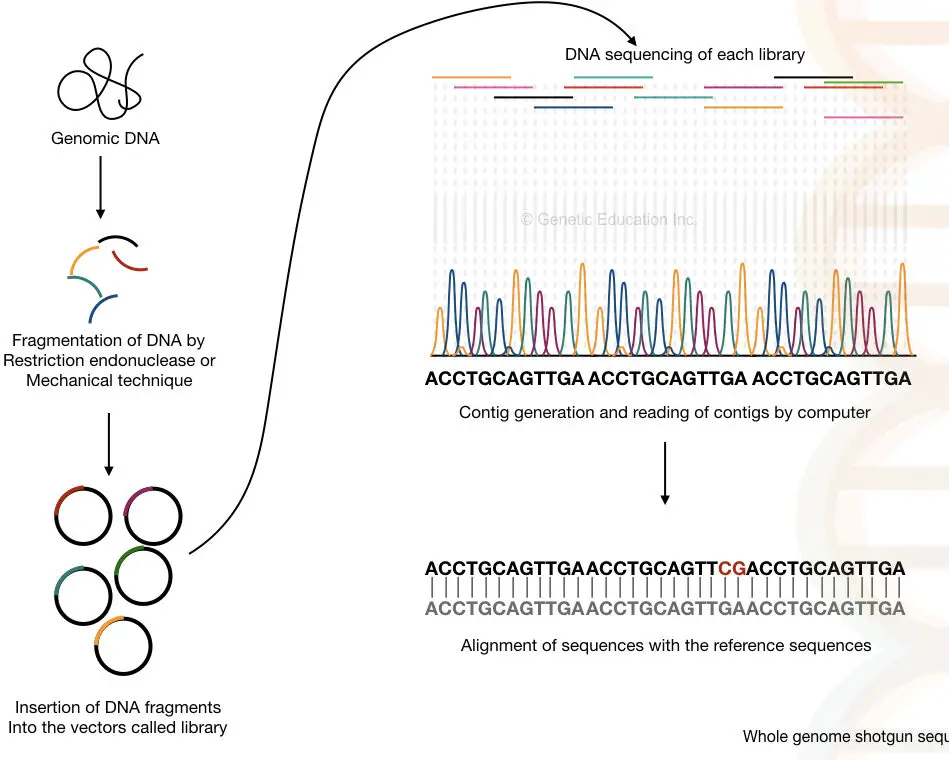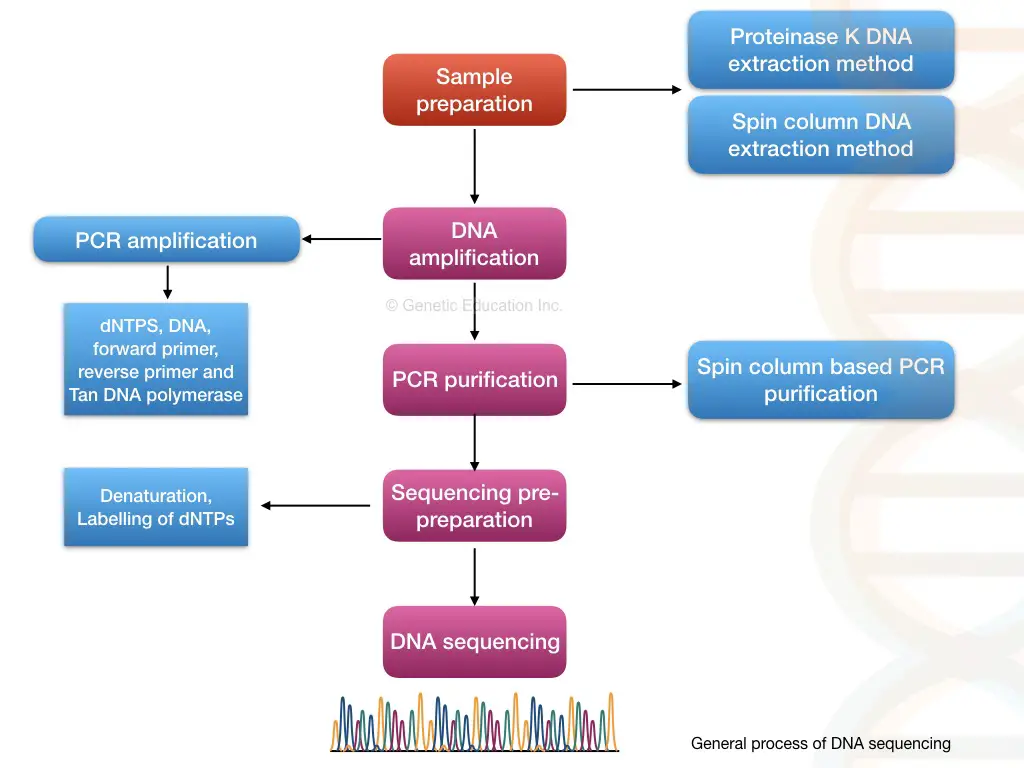Add adapters to DNA fragments 6. It has for example provided an important tool for determining the thousands of nucleotide variations associated with specific genetic diseases like Huntingtons which may.
These strict pairings enable the two DNA chains to bond and coil into its distinctive double.

. The next reagent used in it is DNA primers. Now you understand that the labeled nucleotides are one of the ingredients in DNA sequencing. A typical sequencing experiment involves fragmentation of the genome into millions of molecules which are size-selected and ligated to adaptersThe set of fragments is referred to as a sequencing library which is sequenced to.
This provides a complete genetic map with all the traits issues and defects that may affect the individual. The sequence tells scientists the kind of genetic information. When sequencing ancient DNA what is the next step in the sample __Perform end-repair - Ligate the adapters - Perform fragmentation - Perform A-overhang.
Sequencing DNA means determining the order of the four chemical building blocks - called bases - that make up the DNA molecule. Any nucleotide difference between the reference sequence and the ancient DNA reads is a putative private variation. The amplification step makes it possible to do DNA testing from very small starting amounts like those in forensic samples or ancient bones.
The first step is the isolation of the cell DNA. Why do we skip the fragmentation part when we are sequencing ancient DNA like this sample. To get started upload your raw DNA data from any DNA test or genome sequencing test.
The invention of next-generation-sequencing has revolutionized almost all fields of genetics but few have profited from it as much as the field of ancient. Bacterial cloning step is required to amplify the genomicfragmentinabacterialintermediateas is done in traditional sequencing approaches. Extensive computational analysis is required to interpret the results.
Up to 10 cash back Abstract. These are immobilised in a flow. Their next step is to explore what happens when individual variants are put into human cells said Ahituv.
DNA sequencing is used to calculate the exact order of the bases in a strand of DNA. Importantly both the Helicos and Pacific Biosystems instruments mentioned above are so-called single molecule sequencers and do not require any amplification of DNA fragments prior to sequencing. What is DNA sequencing.
DNA is comprised of nucleotides with each nucleotide consisting of a sugar a phosphate group and a base. Next follows the actual DNA sequencing reaction. A Hands-On Activity for Introducing Microbiology Students to Next-Generation DNA Sequencing and Bioinformatics.
In the final step the DNA profile is analyzed by a computer and the final DNA sequencing data is then presented in a usable format. When sequencing ancient DNA what is the next step in the sample preparation after we have extracted the DNA from the bone. Unlike PCR labeled nucleotides are used in DNA sequencing.
Here the labs dont hone in on a specific market but instead sequence the entire genome in full. A Library of Ancient DNA to Test in Modern Human Cells. Two important BLAST parameters must be considered to obtain robust results.
The four bases are adenine A thymine T cytosine C and guanine G and together they form two base pairsadenine with thymine and cytosine with guanine. The second Method H modifies the first by adding an initial EDTA wash and an extended digestion and decalcification step. What is DNA sequencing.
Within double stranded DNA dsDNA bases from single stranded DNA ssDNA will form pairs with the bases on the other ssDNA. DNA sequencing refers to the process of identifying the order of bases in a strand of DNA. The gap opening penalty g and the e-value e.
After that the resulting DNA fragments are separated by their size. This app analyzes and compares your DNA to ancient genomes. In DNA sequencing a read is an inferred sequence of base pairs or base pair probabilities corresponding to all or part of a single DNA fragment.
DNA extraction template preparation library construction sequencing data gathering and results interpretation are some of the key steps in DNA sequencing. Whole genome sequencing is the next step up in many ways. The method known as sequencing by synthesis SBS starts by fragmenting DNA into many small single stranded pieces.
Read two of our best article on DNA sequencing. The human genome contains about 3 billion base pairs that spell out the instructions for making and maintaining a human being. No significant difference was found in overall ancient DNA yields or post-mortem damage patterns recovered from samples extracted with either method irrespective of tissue type.
When sequencing ancient DNA what is the next step in the sample preparation after we have extracted the DNA from the bone. However Method H samples had higher endogenous. Add adenine to 3 end 5.
What is the purpose of the end -. Resources for Healthcare Providers. Sequence variations are detected by mapping reads from ancient DNA on a reference sequence using BLAST.
The second phase involves breaking up the DNA and inserting its pieces into vectors cells that indefinitely self-replicate for cloning. High-throughput sequencing HTS allows fast and cost-efficient sequencing of ancient DNA aDNA without prior information about what sequences should be targeted. One necessary step for HTS is the preparation of a sequencing library.
A process on Sanger sequencing in which a peak is generated after fluorescence emission. Common four key steps of DNA sequencing are In the first step DNA is removed from the cell. These tests are far more costly.
Commercial kits are available for this purpose but many of these are not suitable for. NHGRI - The Cost of Sequencing a Human Genome. This can be achieved either mechanically or chemically.
The first step in DNA sequencing process is to extract the DNA. In the process of analyzing these variants Ahituv and Harshman created a catalog of archaic DNA sequences that they and other researchers can investigate one by one. DNA sequencing played a pivotal role in mapping out the human genome completed in 2003 and is an essential tool for many basic and applied research applications today.

Dna Sequencing History Steps Methods Applications And Limitations

How Do You Put A Genome Back Together After Sequencing Facts Yourgenome Org

Choosing A Next Generation Sequencing Pipeline Rna Seq Blog Next Generation Sequencing Fun Science Sequencing

Dna Sequencing History Steps Methods Applications And Limitations

0 Comments